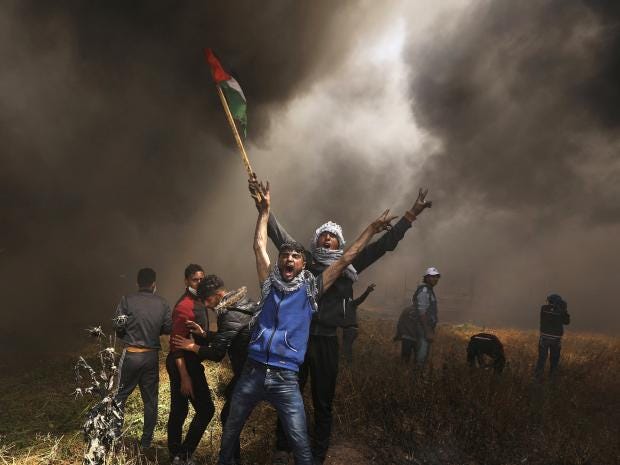
PATRICK COCKBURN
Protests in Gaza are leading to many deaths and injuries among Palestinians, yet Israel has faced little criticism
The political price of besieging or blockading urban areas like Gaza is rising because it is impossible to prevent information about the sufferings of those trapped inside such an enclaves becoming public

The sheer scale of the casualties on the first day of the protest a week ago is striking, with as many as 16 killed and 1,415 injured, of whom 758 were hit by live fire according to Gaza health officials Reuters
Thousands of protesters returned to the border this Friday, burning great heaps of tyres to produce a black smokescreen which they hoped would hide them from Israeli snipers. Gaza’s health ministry has said that five people were killed and 1,070 people were wounded on Friday, including 293 by live fire.
The demonstrators know what to expect. A video from the first day of the march shows a protester being shot in the back by an Israeli sniper as he walks away from the fence separating Gaza from Israel. In other footage, Palestinians are killed or wounded as they pray, walk empty-handed towards the border fence, or simply hold up a Palestinian flag. All who get within 300 yards are labelled “instigators” by the Israeli army, whose soldiers have orders to shoot them.
“Nothing was carried out uncontrolled; everything was accurate and measured, and we know where every bullet landed,” claimed a tweet from the Israeli military the day after the mass shooting on 30 March at the start of 45 days of what Palestinians call the “Great March of Return” to the homes they had in Israel 70 years ago. The tweet was deleted soon after, possibly because film had emerged of a protester being shot from behind.
The sheer scale of the casualties on the first day of the protest a week ago is striking, with as many as 16 killed and 1,415 injured, of whom 758 were hit by live fire according to Gaza health officials. These figures are contested by Israel, which says that the injured numbered only a few dozen. But Human Rights Watch spoke to doctors at Shifa Hospital in Gaza City who said that they had treated 294 injured demonstrators, mostly “with injuries to the lower limbs from live ammunition”.
Imagine for a moment that it was not the two million Palestinian in Gazay, Lebanon and Jordan who had staged a march to return to the homes that they have lost in Syria since 2011. Suppose that, as they approach the Syrian border, they were fired on by the Syrian army and hundreds of them were killed or injured. Syria would certainly claim that the demonstrators were armed and dangerous, though this would be contradicted by the absence of casualties among the Syrian military.
The international outcry against the murderous Syrian regime in Washington, London, Paris and Berlin would have echoed around the world. Boris Johnson would have denounced Assad as a butcher and Nikki Haley, the US ambassador to the UN, would have held up pictures of the dead and dying before the Security Council.
Of course, Israel would furiously deny that there was any parallel between the two situations. Its government spokesman, David Keyes, rebuked CNN for even using the word “protest” when “what actually happened is that Hamas engineered an event where they wanted thousands of people to swarm into Israel, to crush Israel, to commit acts of terror. Indeed, we have captured on camera pictures of people shooting guns, people placing bombs, people shooting rockets.”
In the event, no pictures of these supposedly well-armed protesters ever emerged. But four days later, Human Rights Watch published a report entitled Israel: Gaza Killings Unlawful, Calculated. Officials Green-Light Shooting of Unarmed Demonstrators, which said that it “could find no evidence of any protester using firearms”. It added that footage published by the Israeli army showing two men shooting at Israeli troops turned out not to have been filmed at the protest.
Israeli ministers are unabashed by the discrediting of claims that the demonstrators pose a military threat to Israel. Defence minister Avigdor Lieberman said that Israeli soldiers had “warded off Hamas military branch operatives capably and resolutely ... They have my full backing.” The free-fire policy is continuing as before and, as a result, the Israeli human rights organisation, B’Tselem, has launched a campaign called “Sorry Commander I Cannot Shoot”, which encourages soldiers to refuse to shoot unarmed civilians on the grounds that this is illegal.
Why is the surge in Palestinian protests coming now and why is Israel responding so violently? There is nothing new in Palestinian demonstrations about the loss of their land and Israel’s aggressive military response. But there may be particular reasons that a confrontation is happening now, such as Palestinian anger at President Trump’s decision in December to recognise Jerusalem as the capital of Israel and the move of the US embassy to there from Tel Aviv. This trumpeted Washington’s unconditional support for the Israeli position and the US disregard for the Palestinians and any remaining hopes they might have to win at least some concessions with US support.
Strong support from the Trump administration is reported by the Israeli press to be further reason why the Israeli prime minister, Benjamin Netanyahu, feels that bad publicity over the shootings in Gaza will not damage Israel’s position in the US. In the past, controversy over the mass killings of Palestinian or Lebanese by Israel has sometimes provoked a negative US response that has curbed Israel’s use of force.
So far, Israel has faced little criticism from an international media uninterested in the Gaza story, or else is happy to go along with Israel’s interpretation of events. The vocabulary used by news outlets is often revealing: for instance, the BBC website on 31 March had a headline reading “Gaza-Israel border: Clashes ‘leave 16 Palestinians dead and hundreds injured”. The word “clashes” implies combat between two groups capable of fighting each other, though, as Human Rights Watch says, the demonstrators pose no threat to an all-powerful Israeli military machine – a point reinforced by the fact that all the dead and wounded are Palestinian.
Possibly, the Israelis are miscalculating the impact of excessive use of force on public opinion: in the age of wifi and the internet, graphic images of the victims of violence are immediately broadcast to the world, often with devastating effect. As in Syria and Iraq, the political price of besieging or blockading urban areas like Gaza or Eastern Ghouta is rising because it is impossible to prevent information about the sufferings of those trapped inside such an enclaves becoming public, though this may have no impact on the course of events.
Contrary to Keyes’ claims, the idea of a mass march against the fence seems to have first emerged in social media in Gaza and was only later adopted by Hamas. It is the only strategy likely to show results for the Palestinians because they have no military option, no powerful allies and their leadership is moribund and corrupt. But they do have numbers: a recent report to the Israeli Knesset saying that there are roughly 6.5 million Palestinian Arabs and an equal number of Jewish Israeli citizens in Israel and the West Bank, not counting those in East Jerusalem and Gaza. Israel has usually had more difficulty in dealing with non-violent civil rights type mass movements among Palestinians than it has had fighting armed insurgencies.
Keyes claims that the demonstrations are orchestrated by Hamas, but here again he is mistaken on an important point because witnesses on the spot say that the impetus for the protests is coming from non-party groups and individuals. They voice frustration with the failed, divided and self-seeking Palestinian leaders of both Hamas and Fatah. The most dangerous aspect of the situation in terms of its potential for violence may be that nobody is really in charge.
Geen opmerkingen:
Een reactie posten
Opmerking: Alleen leden van deze blog kunnen een reactie posten.